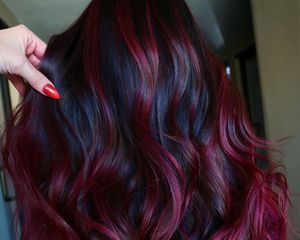:max_bytes(150000):strip_icc()/Stocksy_txp7998e7c1uti300_Medium_3992208-53738fafb85941838864052faaddcbb6.jpg)
Stocksy
Whether your attempt at at-home hair color went wrong or you just can't make it into a salon, we understand if you've found yourself taking hair dye stripping into your own hands. Luckily, there are several expert-approved ways to lift unwanted color at home when you're in a pinch. While a professional service will always be the safest and most thorough, these methods have major potential for results in many cases—plus most of them use products you probably have already in your bathroom or kitchen. Ahead, hairstylists and colorists offer six key tips on how to strip hair color at home if you're determined to go the DIY route.
Meet the Expert
- Cheryl Bergamy is a New York-based celebrity hairstylist who has worked with John Legend, Demi Lovato, and 50 Cent, among others. She is also the founder of Contents Haircare.
- Michelle Garwood is a session stylist and colorist based in Perth, Australia. Having spent the last 6 years working in London and New York, she has recently relocated to the salon George and Ivy.
- George Papanikolas is a hair colorist and Matrix brand ambassador based between Los Angeles and New York City. High-profile clients over the years include Ana de Armas, Britney Spears, and Laverne Cox.
Does At-Home Color Stripping Work?
When you decide to strip hair color at home, it's important to understand how the process works and what results you might expect. "Whenever you are removing artificial hair color, you will pull up the underlying orange/red pigment," says colorist and Matrix brand ambassador George Papanikolas. "Then, you will need to go back and recolor the hair your desired tone."
While you have several options for DIY color stripping—from common household products to clarifying shampoo—Papanikolas says that ultimately, nothing is quite as powerful as bleach. "Using a bleach or a bleaching color remover are the ideal methods to remove color up to nine shades lighter," he explains. "You can use clarifying shampoo as well, but that will give minimal lightening and will take several sessions over a few weeks." If you decide to go the gentle lightening route, you have several DIY options, though the safest ones may not work on color that's particularly dark or vivid.
All at-home color stripping methods, especially bleach, carry some degree of risk for dryness and damage to the hair. "To strip color requires you to use a bleaching agent," Papanikolas tells us. "These can be harsh on the hair and give uneven results."
At the end of the day, "remember these methods won't perform miracles," says stylist and colorist Michelle Garwood. "The only way to lift the hair lighter than the results these methods will give you is to see a professional stylist. If you know your hair is in poor condition already, I would definitely recommend at least speaking to your stylist for advice on how to proceed." If you're worried about whether your hair will tolerate at-home color stripping, it's always better to be safe than sorry.
Hair Type Considerations
Stripping color at home isn't one-size-fits-all when it comes to hair types. For starters, if you have previously bleached hair, Garwood says the hair has already been compromised by the treatment and is more prone to damage and dryness. "Same goes for finer hair, or anyone who has colored their hair multiple times over a short period," she adds.
When it comes to texture, "these methods can be damaging for fine hair and curly hair," notes celebrity hairstylist Cheryl Bergamy. "Curly and coily hair is naturally drier, and fine hair is more delicate. 1-3A natural textures can use these suggested methods, as their textures will naturally hold more oil, but textures 3B-4C would have to use more caution. These textures hold less oil, and therefore these at-home methods can be extremely drying and damaging to those hair types."
Ways to Strip Hair Color at Home
Vitamin C
One way to safely attempt stripping your hair color at home is by using vitamin C. "Although vitamin C is a great antioxidant," Bergamy says, "it can also be used to oxidize color." It achieves this oxidization by loosening up hair dye molecules, she claims.
What You'll Need:
- Vitamin C (either pills or powdered packets)
- Water
The Process:
- Bergamy says to start by mixing powdered packets or crushed up pills with a small amount of hot water until it forms into a paste.
- Once mixed, apply the combination to the hair and put on a plastic cap or shower cap for 45 minutes.
- Then, rinse it out well using warm to hot water.
It may take a few attempts depending on your hair and the color you're trying to remove, but you should begin to see that unwanted color start to fade. "The acid in vitamin C oxidizes the dye and loosens up its hold on your hair," Bergamy says.
Clarifying Shampoo
We all know that using certain shampoos will help preserve our hair color, so it isn't a big surprise that clarifying shampoo will help you do just the opposite. "Clarifying shampoos are designed to remove minerals, pollution, and chemical buildup on your strands (like chlorine, silicone, etc.)," Garwood explains, adding that this effect also applies to unwanted pigments. "Just by washing your hair, you should see a gentle lift of the dye," Bergamy adds, "especially if it’s semi-permanent."
What You'll Need:
- Clarifying shampoo
- Water
- Deep conditioner
- Shower cap or saran wrap
The Process:
- Apply clarifying shampoo to your hair, then lather and rinse as you normally would.
- Wring your hair dry to remove excess water.
- Wash your hair with clarifying shampoo a second time, massaging it in until you have a good, heavy lather.
- Let the product sit in your hair with a shower cap on for five to 10 minutes. "You can also use saran wrap to wrap around your hair like a turban," Garwood says.
- Rinse out the clarifying shampoo, then follow with a good deep conditioner to ensure your strands don't lose too much moisture. "You always want to condition afterwards to close your cuticle back down," Garwood tells us.
"I don't recommend doing this treatment often, as you need your natural oils to be present and over-clarifying will remove them, causing your hair and scalp to feel dry," Garwood says. But doing this dual, thorough wash a few times in a row, or every other time you wash your hair, is a relatively safe way to strip unwanted color enough to discontinue the shampoo treatments.
White Vinegar
White vinegar is one of those superhero pantry products that can do a lot more than its typical uses. According to Bergamy, this common ingredient can bring out natural shine and help strip unwanted hair color. "Vinegar is going to work the best on semi-permanent colors," she says. "It can fade permanent hair color too, but it will not totally remove it."
What You'll Need:
- White vinegar
- Water
- Shower cap
- Strengthening or bonding treatment
The Process:
- Mix half a cup of white vinegar with half a cup of warm water.
- Gently pour the mixture onto your hair, then "cover your head with a shower cap for 15 to 20 minutes before rinsing," Bergamy says.
- Repeat as needed—Bergamy explains that "you may need to do this process more than once to see results."
- If you use this solution for three consecutive days, she highly recommends following up with "a strengthening or bonding treatment to secure the bonds of the hair."
Dishwashing Liquid
Proceed with caution on this one, Byrdies: While dishwashing liquid is more powerful than some of the other methods to strip hair color at home, Garwood says that it can be quite damaging if used more than once. "[Dishwashing liquid] isn't designed to wash our hair and has many strong cleansing agents not present in a professional shampoo, so it will strip color for sure," she says. "Doing it more than once, however, can really dry your hair out."
What You'll Need:
- Dishwashing liquid
- Water
- Conditioner
- Protein or repairing hair treatment
The Process:
- Garwood says to lather the dishwashing liquid into wet hair, then leave it on for up to five minutes.
- Rinse well to be sure none of the harsh liquid remains in your hair.
- Follow with a good conditioner—this is a step you definitely don't want to skip, according to Garwood.
- "If you have a protein or repairing hair treatment, I'd advise applying that afterwards to ensure your cuticle closes back down, keeping your hair strong and healthy," Garwood says.
Baking Soda
We've seen baking soda used for many hair DIYs, from scalp care to highlights to dry shampoo. "Baking soda works as a scrubbing agent," Bergamy explains. "[It will] gently strip off the color from the surface of the hair without damaging the quality of your strands." This option is best for fresh hair color that's only one to four days old, so consider it a method for when you're having immediate regret.
What You'll Need:
- Baking soda
- Water
- Conditioner
The Process:
- To begin, Bergamy suggests combining two tablespoons of baking soda with half a cup of water and applying the mixture to wet hair.
- "Work the mixture in from roots to ends for about 10 minutes, and then rinse," Bergamy instructs.
- Follow with a conditioner to restore any lost moisture to the hair.
Sulfur-based Hair Strippers
Sulfur-based products intended for stripping hair color at home can be quite effective. Be sure to follow the instructions exactly, and be aware that these types of treatments can be fairly drying on your hair. You'll usually want to avoid color-treating your hair for a few months after using a sulfur-based stripper, so chat with a professional if you're looking for a safe way to switch up your color sooner.
What You'll Need:
- The hair color remover product of your choice
- Water
- Conditioner
- Any other items the instructions specify
The Process:
- Mix and apply the color stripper according to the instructions.
- Let it sit for the amount of time specified, then rinse well.
- Follow with a quality conditioner. Keep this in your regular routine to restore moisture to the hair following the treatment.
The Final Takeaway
Stripping hair color at home is possible and you have several options, though you'll want to note that the most powerful ones pose more of a risk for dryness and damage. DIY color stripping is most effective if your color is semi-permanent or if you only need to remove a limited amount of pigment—the more intense the color, the more complicated removal will be. "Clarifying shampoo is the easiest at home to get it slightly lighter," Papanikolas says. "This usually works for hair that has had a toner that is slightly darker than you would like. Anything darker than that requires professionals, and it’s not recommended to do at home. Even for a professional colorist, the results are unpredictable and [can be uneven], then need to be followed up with another color to correct the underlying tones from the stripping process."













